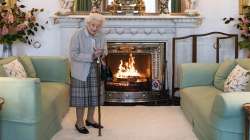Queen Elizabeth II, Britain's longest-serving monarch, dies after 70 years of reign in Scotland aged 96
Queen Elizabeth II death: Queen Elizabeth II passes away at 96, Buckingham Palace informed on Thursday. The palace said that Queen died peacefully at Balmoral in the afternoon.

Queen Elizabeth II death: Queen Elizabeth II passes away at 96, Buckingham Palace informed on Thursday. The palace said that Queen died peacefully at Balmoral in the afternoon. Earlier this evening, Buckingham Palace in a health bulletin had said that doctors were concerned about her health.
Post the development, family members of Queen Elizabeth had rushed to her Scottish home Balmoral Castle.
The palace announced she died at Balmoral Castle, her summer residence in Scotland, where members of the royal family had rushed to her side after her health took a turn for the worse.
A link to the almost-vanished generation that fought World War II, she was the only monarch most Britons have ever known, and her name defines an age: the modern Elizabethan Era.
The impact of her loss will be huge and unpredictable, both for the nation and for the monarchy, an institution she helped stabilize and modernize across decades of huge social change and family scandals.
With the death of the queen, her 73-year-old son Charles automatically becomes monarch, though the coronation might not take place for months. It is not known whether he will choose to call himself King Charles III or some other name.
The queen’s life was indelibly marked by the war. As Princess Elizabeth, she made her first public broadcast in 1940 when she was 14, sending a wartime message to children evacuated to the countryside or overseas.
“We children at home are full of cheerfulness and courage,” she said with a blend of stoicism and hope that would echo throughout her reign. “We are trying to do all we can to help out gallant soldiers, sailors and airmen. And we are trying, too, to bear our own share of the danger and sadness of war. We know, every one of us, that in the end all will be well.”
Since Feb. 6, 1952, Elizabeth reigned over a Britain that rebuilt from war and lost its empire; joined the European Union and then left it; and transformed from industrial powerhouse to uncertain 21st century society. She endured through 15 prime ministers, from Winston Churchill to Liz Truss, becoming an institution and an icon -- a fixed point and a reassuring presence even for those who ignored or loathed the monarchy.
She became less visible in her final years as age and frailty curtailed many public appearances. But she remained firmly in control of the monarchy and at the center of national life as Britain celebrated her Platinum Jubilee with days of parties and pageants in June 2022.
The same month she became the second longest-reigning monarch in history, behind 17th-century French King Louis XIV, who took the throne at age 4. On Sept. 6, 2022, she presided at a ceremony at Balmoral Castle to accept the resignation of Boris Johnson as prime minister and appoint Truss as his successor.
When Elizabeth was 21, almost five years before she became queen, she promised the people of Britain and the Commonwealth that “my whole life, whether it be long or short, shall be devoted to your service.”
It was a promise she kept across more than seven decades.
Despite Britain’s complex and often fraught ties with its former colonies, Elizabeth was widely respected and remained head of state of more than a dozen countries, from Canada to Tuvalu. She headed the 54-nation Commonwealth, built around Britain and its former colonies.
Married for more than 73 years to Prince Philip, who died in 2021 at age 99, Elizabeth was matriarch to a royal family whose troubles were a subject of global fascination -- amplified by fictionalized accounts such as TV series “The Crown.” She is survived by four children, eight grandchildren and 12 great-grandchildren.
Through countless public events, she probably met more people than anyone in history. Her image, which adorned stamps, coins and banknotes, was among the most reproduced in the world.
But her inner life and opinions remained mostly an enigma. Of her personality, the public saw relatively little. A horse owner, she rarely seemed happier than during the Royal Ascot racing week. She never tired of the companionship of her beloved Welsh corgi dogs.
Elizabeth Alexandra Mary Windsor was born in London on April 21, 1926, the first child of the Duke and Duchess of York. She was not born to be queen -- her father’s elder brother, Prince Edward, was destined for the crown, to be followed by any children he had.
But in 1936, when she was 10, Edward VIII abdicated to marry twice-divorced American Wallis Simpson, and Elizabeth’s father became King George VI.
Princess Margaret recalled asking her sister whether this meant that Elizabeth would one day be queen. ”’Yes, I suppose it does,’” Margaret quoted Elizabeth as saying. “She didn’t mention it again.”
Elizabeth was barely in her teens when Britain went to war with Germany in 1939. While the king and queen stayed at Buckingham Palace during the Blitz and toured the bombed-out neighborhoods of London, Elizabeth and Margaret spent most of the war at Windsor Castle, west of the capital. Even there, 300 bombs fell in an adjacent park, and the princesses spent many nights in an underground shelter.
In 1945, after months of campaigning for her parents’ permission to do something for the war effort, the heir to the throne became Second Subaltern Elizabeth Alexandra Mary Windsor in the Auxiliary Territorial Service. She enthusiastically learned to drive and service heavy vehicles.
(With inputs from AP)